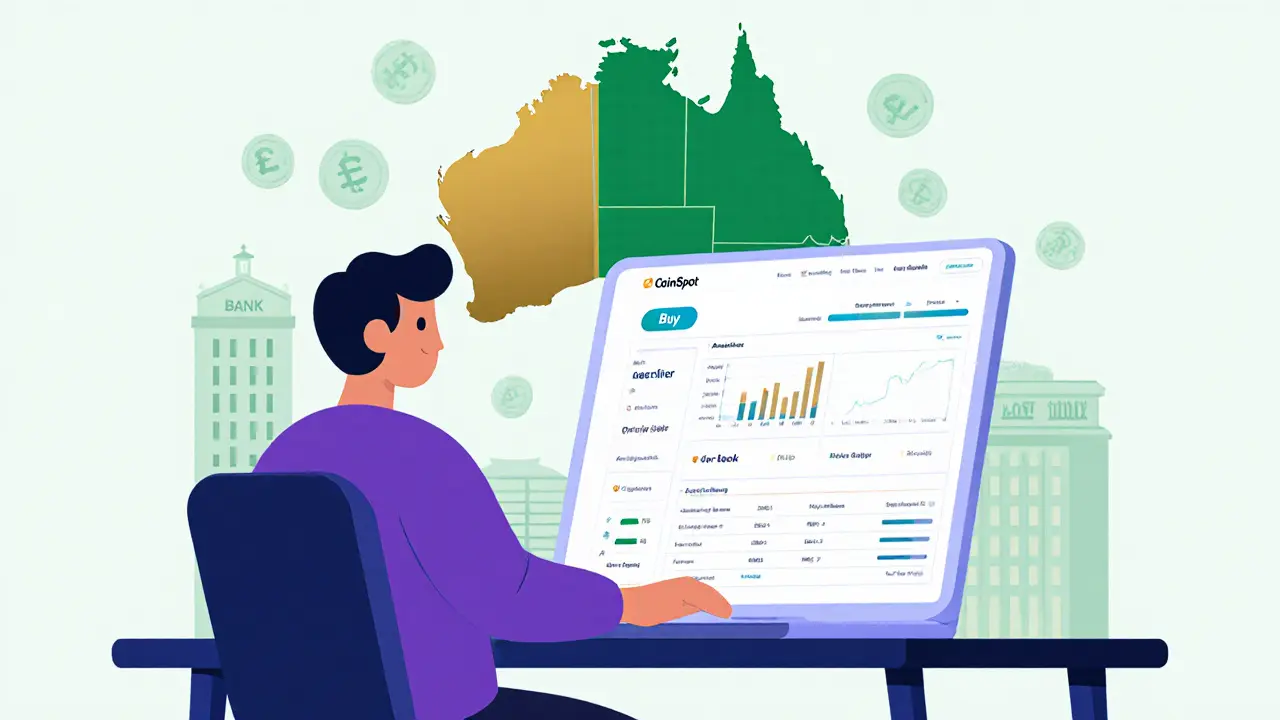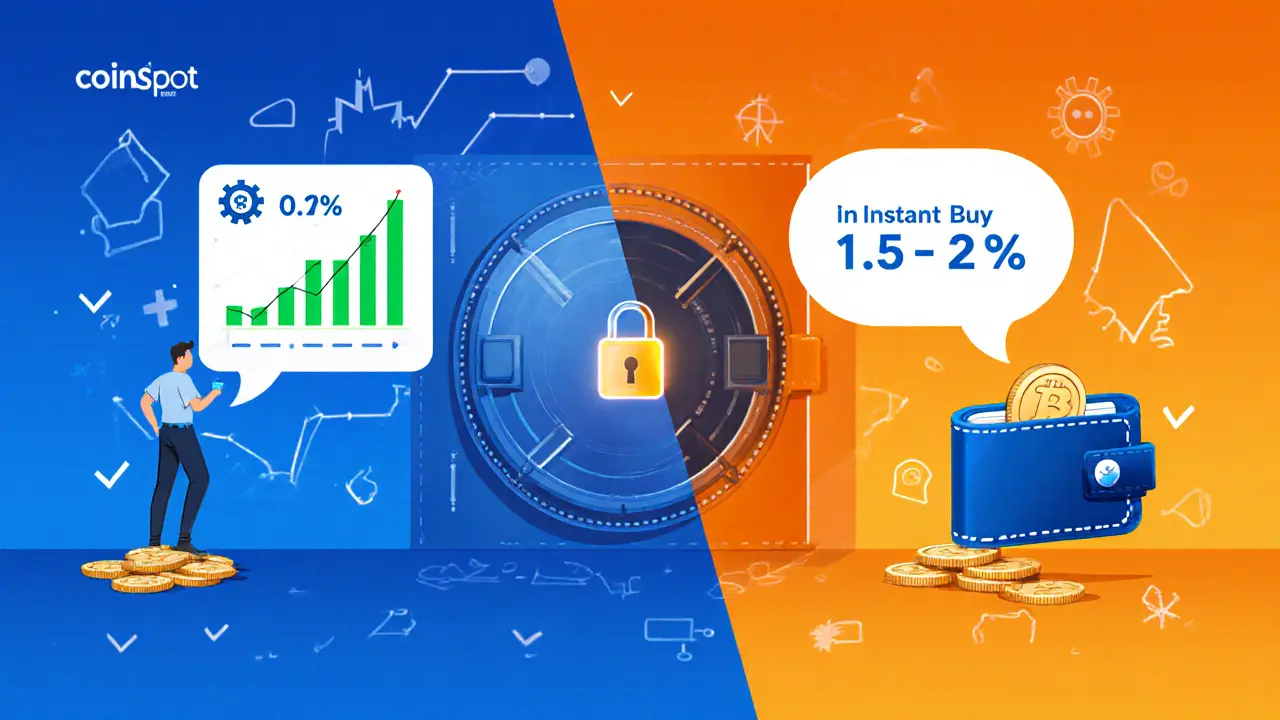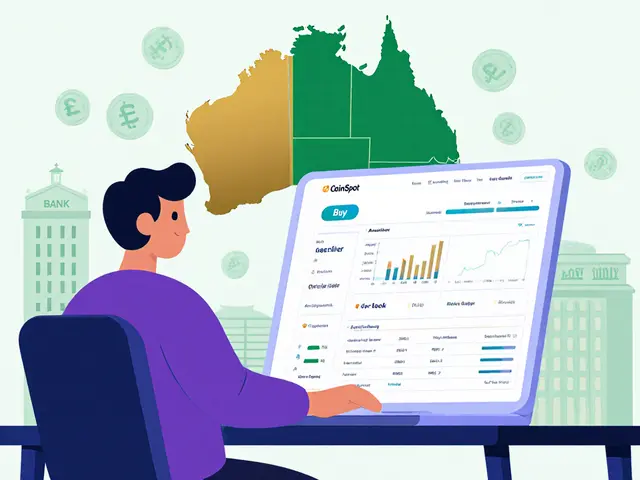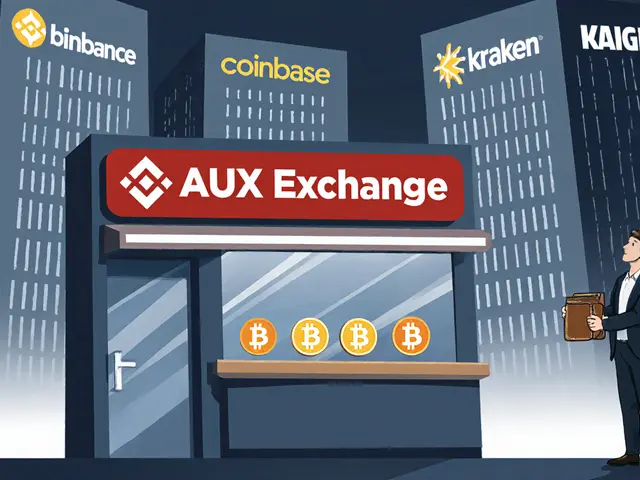CoinSpot Crypto Exchange Review 2025: Fees, Security & Features

CoinSpot Fee Calculator
Fee Comparison Summary
- Market Order Fee 0.1%
- Instant Buy Spread 1.5–2.5%
- Security 98% Cold Storage
- Regulation AUSTRAC Registered
When it comes to buying crypto in Australia, CoinSpot is the country's largest cryptocurrency exchange, launched in 2013 and serving over 2.5million users. The platform markets itself as beginner‑friendly while also offering tools that seasoned traders can appreciate. If you’re weighing whether to put your Australian dollars (AUD) on CoinSpot, this review breaks down the most important aspects - from asset coverage and fee schedules to security practices and overall user experience.
Quick Takeaways
- Largest Australian exchange with >2.5million users.
- Supports roughly 500+ cryptocurrencies, far more than most global rivals.
- Market‑making fees sit at 0.1%, but instant‑buy spreads can exceed 2%.
- Over 98% of funds stored in cold wallets; audited 1:1 asset‑to‑customer ratio in 2023.
- Full AUSTRAC registration, mandatory KYC, and built‑in tax reporting for the ATO.
Supported Assets - Quantity Meets Variety
Bitcoin and Ethereum are, of course, available, but CoinSpot’s real edge is the breadth of its catalogue. Independent audits list between 400 and 537 tradable tokens, covering everything from the top‑30 market‑cap coins to niche memecoins and Australia‑focused blockchain projects that you won’t find on many international platforms.
For traders chasing early exposure, this means you can snap up a freshly listed token on CoinSpot within days of its Australian market debut. The trade‑off? Some of those assets experience higher volatility and lower liquidity than the blue‑chip coins.
Fee Structure - Low‑Cost Market Orders, High‑Cost Instant Buys
CoinSpot distinguishes between two pricing models:
- Market Trading Fees: Limit and market orders incur a flat 0.1% fee, which is competitive even against major global exchanges.
- Instant Buy/Sell Fees: The platform adds a spread that typically ranges from 1.5% to 2.5% on the spot price. For newcomers who prefer the one‑click experience, this can bite into small‑scale investments.
To put it in perspective, buying AUD1,000 worth of Bitcoin via an instant purchase could cost you an extra AUD20-25 compared with a limit order. Frequent traders often avoid the instant route to keep costs down.

Security & Compliance - A Fortress for Australian Users
Security is a major decision factor for any exchange. CoinSpot stores more than 98% of its crypto holdings in offline cold wallets, shielding assets from remote hacks. A 2023 third‑party audit confirmed a 1:1 ratio between customer balances and the platform’s reserves - a reassuring sign after several high‑profile exchange failures worldwide.
Regulatory compliance is equally solid. CoinSpot is fully registered with AUSTRAC, Australia’s anti‑money‑laundering watchdog, and enforces a thorough KYC (Know Your Customer) process for every user. The platform also integrates tax‑reporting tools that align with Australian Taxation Office (ATO) requirements, simplifying year‑end reporting for traders.
User Experience - Simplicity Meets Functionality
The dashboard is deliberately clean: a large “Buy” button, a concise portfolio view, and a straightforward order‑book layout. New users often praise the ease of depositing AUD via local bank transfers, which settle within standard Australian banking hours.
Advanced features are available but not buried. You can set limit orders, view detailed candlestick charts, and even trade on the built‑in NFT marketplace - an emerging component that lets Australian users buy, sell, and mint NFTs without leaving the platform.
Where CoinSpot falls short is the lack of a demo or sandbox environment. Beginners have to risk real funds to practice, and educational content is limited compared with rivals that host extensive video tutorials or webinars.
CoinSpot vs. Coinbase - A Side‑by‑Side Look
| Feature | CoinSpot | Coinbase |
|---|---|---|
| Supported cryptocurrencies | ≈500+ | ≈324 |
| Instant‑buy spread | 1.5-2.5% | 0.5-1.0% |
| Market‑making fee | 0.1% | 0.5% |
| AUD deposits/withdrawals | Yes, local bank integration | No (requires conversion) |
| Cold‑wallet storage | 98% offline | ~95% offline |
| Regulatory registration | AUSTRAC, AML/CTF compliant | US FinCEN, state licenses |
| Educational resources | Limited | Extensive video library & webinars |
In short, CoinSpot shines for Australian users who need AUD‑centric banking and a massive token list, while Coinbase remains attractive for lower instant‑buy fees, stronger educational content, and broader global reach.

Who Should Use CoinSpot?
Based on the strengths and weaknesses outlined above, here are the most common user personas that benefit from CoinSpot:
- Australian beginners who value a simple UI, local bank integration, and direct AUD deposits.
- Token hunters looking for early access to niche or Australia‑specific projects that larger exchanges haven’t listed yet.
- Intermediate traders who prefer low 0.1% market fees and can manage the occasional higher spread on instant buys.
Conversely, high‑frequency day traders or users primarily focused on the lowest possible transaction costs might want to keep a secondary account on a platform with cheaper instant‑buy spreads, such as Binance or Kraken.
Future Outlook - Staying Relevant in a Competitive Market
CoinSpot’s solid regulatory footing and expansive token catalog give it a sturdy foundation. However, the exchange will need to address two key growth areas to retain its lead:
- Fee competitiveness: Tightening instant‑buy spreads could attract more casual investors who balk at the current premium.
- Education & demo tools: Adding a sandbox mode and richer learning resources would lower the barrier for newcomers and reduce reliance on external tutorials.
If the platform evolves in these directions, its position as Australia’s go‑to crypto hub should remain strong even as international players increase their local presence.
Key Takeaway
For anyone in Australia who wants a mix of beginner‑friendly design, local banking ease, and a massive selection of digital assets, CoinSpot review points to a solid, secure choice - provided you’re comfortable navigating higher instant‑buy fees and a relatively sparse educational library.
Frequently Asked Questions
Is CoinSpot regulated in Australia?
Yes. CoinSpot is registered with AUSTRAC and follows Australian AML/CTF regulations, meaning all users must complete KYC verification.
How many cryptocurrencies can I trade on CoinSpot?
The exchange lists roughly 500+ tokens, including all top‑30 market‑cap coins and many niche projects that are often absent from larger global platforms.
What are the fees for buying crypto instantly?
Instant purchases carry a spread of about 1.5% to 2.5% over the market price, which is higher than the 0.1% fee applied to limit or market orders.
Are my funds safe on CoinSpot?
Yes. Over 98% of assets are held in cold storage, and a 2023 audit verified a 1:1 reserve ratio, indicating full backing of customer balances.
Can I trade NFTs on CoinSpot?
CoinSpot includes an integrated NFT marketplace where Australian users can buy, sell, and mint NFTs without leaving the platform.


Jack Stiles
CoinSpot’s fees look pretty low, especially for market orders.
Ritu Srivastava
It’s baffling that a platform boasting 98% cold storage still makes users shoulder the risk of high spreads.
The instant‑buy fees effectively penalize beginners, which feels exploitative.
Regulatory compliance alone doesn’t excuse opaque pricing structures.
Users deserve transparent cost breakdowns without hidden profiteering.
Liam Wells
Whilst the advertised 0.1 % market‑order commission appears competitive, one must consider the ancillary costs inherent to liquidity provision.
Moreover, the variance in instant‑buy spreads (1.5‑2.5 %) introduces a stochastic element that may undermine deterministic trading strategies.
The platform’s AUSTRAC registration, although noteworthy, does not inherently guarantee immunities against systemic vulnerabilities.
Consequently, prospective users should conduct comprehensive due‑diligence prior to capital allocation.
Caleb Shepherd
Most folks don’t realize that the tiny 0.1 % fee is just the tip of the iceberg-behind the scenes there are network‑level charges and hidden spreads that the UI glosses over.
Plus, the fact that CoinSpot is AUSTRAC‑registered means they’re under a veil of government oversight that can be leveraged to collect data, which is something the average trader never hears about.
In short, the platform is cash‑cow‑friendly, but you’re paying with your privacy as well as your cash.
Don Price
When evaluating CoinSpot, one cannot overlook the juxtaposition of its glossy marketing veneer against the gritty reality of hidden costs.
The advertised 0.1 % market‑order fee is, on paper, a bargain, yet it conveniently omits the inevitable network transaction fees that silently erode profits.
Instant‑buy spreads, ranging from 1.5 % to 2.5 %, are presented as a convenience but they effectively serve as a tax on the uninformed.
Moreover, the platform’s claim of 98 % cold storage, while reassuring, does not address the systemic risk of centralisation.
Being AUSTRAC‑registered, CoinSpot operates under a regulatory framework that, while ostensibly protective, also enables data collection on user transactions.
This duality raises ethical concerns about the trade‑off between regulatory compliance and personal privacy.
Furthermore, the fee calculator embedded on the site appears user‑friendly, yet it fails to account for the dynamic spread fluctuations that occur during periods of market volatility.
Such omissions can lead to a mismatch between expected and actual costs, leaving traders with unexpectedly thin margins.
From a moral standpoint, exploiting these ambiguities to maximise revenue at the expense of novice investors is questionable.
The platform’s reliance on fiat‑on‑ramp services introduces additional layers of operational risk, especially if those intermediaries suffer from liquidity shortages.
In addition, the lack of transparent reporting on reserve holdings fuels speculation about solvency in extreme market conditions.
Users should be wary of the potential for hidden margin calls disguised as routine fee adjustments.
While CoinSpot markets itself as a secure gateway for Australian crypto enthusiasts, the underlying architecture remains vulnerable to coordinated attacks.
The concentration of assets in a single custodial entity magnifies the impact of any breach, a fact that is seldom highlighted in promotional material.
Consequently, it is incumbent upon the community to demand clearer disclosures and more rigorous auditing standards.
Only through collective vigilance can we hope to curb the subtle predatory practices that have begun to permeate even well‑intentioned exchanges.
Dawn van der Helm
Love how CoinSpot makes crypto accessible with that simple fee calculator – super helpful for newbies! 😊
Monafo Janssen
CoinSpot’s interface feels pretty straightforward, especially when you’re just getting started.
The low market‑order fee is a nice plus, and the Aussie regulation gives a bit of peace of mind.
Michael Phillips
One could argue that the true cost of any exchange is not just the explicit fee, but the hidden friction of trust and control it demands.
Jason Duke
Look, the spread is insane-1.5‑2.5%! If you’re not careful you’ll bleed money before you even realize it.
Bryan Alexander
This platform could be the stepping stone for anyone wanting to dip their toes into crypto without drowning in fees!
Patrick Gullion
Sure, the fees look low, but remember that the biggest cost is often the time you waste figuring out the hidden charges.
Darren Belisle
Well said, folks-CoinSpot does a solid job on security, and for many Australians it’s a decent entry point into the market.
Mark Bosky
While your concerns about spread transparency are valid, it is worth noting that CoinSpot publishes its fee schedule openly on its website, and the spread varies based on market liquidity at the time of execution.
Additionally, the platform offers a market‑order option that bypasses the higher instant‑buy markup entirely.
For users seeking cost‑efficiency, employing limit orders can further mitigate exposure to the advertised spread.
Therefore, the perceived exploitative nature may be mitigated through informed usage.
Brian Lisk
Your exhaustive breakdown certainly illuminates many pain points, yet a few clarifications merit attention.
First, the network transaction fees you mention are network‑level and not under CoinSpot’s control, thus they are a universal cost across exchanges.
Second, the 98 % cold‑storage claim is based on third‑party audits that are publicly available for review.
Third, AUSTRAC registration indeed involves data sharing, but it also imposes stringent AML/KYC standards that protect users from illicit activity.
Fourth, the fee calculator, while not accounting for volatile spreads, does provide a baseline estimate that many users find helpful.
Finally, the concerns about reserve transparency are being addressed by the platform’s upcoming quarterly proof‑of‑reserves publication.
In sum, while the platform is not flawless, many of the highlighted issues are either mitigated or actively being resolved.
Mark Fewster
Your points about hidden fees are noted; however, the platform does disclose network costs in the transaction receipt, which provides a level of transparency.
Ken Pritchard
Absolutely, the straightforward UI is a big plus, and pairing that with regular security updates makes it a solid choice for newcomers.
manika nathaemploy
yeah, the calculator is super handy! but dun forget to check the actual spread before you hit confirm.
Richard Bocchinfuso
i get the formal vibe, but honestly the fees kinda suck when the market is shaky.
EDWARD SAKTI PUTRA
Optimism is great, yet it's essential to keep a realistic view on fee impact over time.
Moses Yeo
One might argue that the ‘insane’ spread is merely a reflection of market dynamics, and not a deliberate ploy; still, traders should remain vigilant.
Debra Sears
Interesting perspective on hidden friction; have you considered the psychological cost of constantly monitoring fees?
Matthew Laird
The hidden charges are a real problem, and it’s high time platforms like CoinSpot get called out for masking true costs.
Melanie LeBlanc
You’re spot‑on about security, Darren-still, let’s keep the conversation balanced and remember that no platform is completely risk‑free.
Jasmine Kate
Whoa, Mark, your 'formal' spiel is a snooze‑fest-people just want to know if they’ll get ripped off!